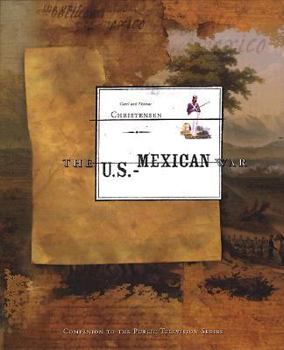U.S.-Mexican War: 1846-1848
Select Format
Select Condition 
Book Overview
The war that President Grant called "the most unjust . . . ever waged by a stronger against a weaker nation" is explored by Mexican and American scholars in this fully illustrated companion to the... This description may be from another edition of this product.
Format:Paperback
Language:English
ISBN:0912333448
ISBN13:9780912333441
Release Date:January 1998
Publisher:Bay Books & Tapes
Length:272 Pages
Weight:2.30 lbs.
Dimensions:0.7" x 9.1" x 11.0"
Customer Reviews
2 ratings
The forgotten war we're still living...
Published by Thriftbooks.com User , 15 years ago
Many in the United States have no idea how their country's borders came to be. Not only that, many remain unaware of the US invasion of Mexico in the years 1846-1848. As forgotten as the War of 1812 or the Spanish-American War, the US-Mexican war forever changed both countries' borders, relations, and standings in the world. This coffee table sized book, sadly out of print, served as a companion volume to a 1998 Public Television series on this war. As such, it is written in very plain language for the general public. Voluminous maps, drawings, sidebars, and even early photos (daguerreotypes) permeate its some 240 pages. A better introduction to this now shamefully obscure war is hard to imagine. Best of all, the book strives to see the conflict from both sides. Whereas Mexico saw the war as a result of American ambition and land lust, the US at the time saw it as a fulfillment of its "Manifest Destiny" and its political and racial superiority. Memories of the war still resonate in Mexico today, as Mexico lost half of its territory in the resulting Treaty of Guadalupe Hidalgo. The map on page 3 shows the war's dramatic consequences. The pre-war Mexican borders stretched to Colorado and west to the northern California coast. All of that was once Mexican land inhabited by thousands of Mexican citizens. 1848 changed that. The book traces the war's roots back to Texas and Mexico's enticing 1824 immigration policies. These lured "Anglo Empresarios" (land speculators) to the Mexican territory of Texas. As their numbers increased, so did their dissatisfaction with Mexican rule. They rebelled and tried to secede. The US press hailed them as "freedom fighters." Mexico smelled a rat. Eventually this tension led to the famous 1836 Alamo and Goliad conflicts where Sam Houston's rebels were routed and massacred by Antonio López de Santa Anna's forces. Houston's troops retaliated with their own massacre at San Jacinto. Texas gained its independence, but the United States began to eye the new Republic for annexation. Mexico warned the US that Texas statehood meant a declaration of war. Not until the 1845 election of President James Polk did the threat of real war materialize. Polk campaigned on Texas statehood and after assuming office sent General Zachary Taylor to that disputed territory with a full regiment of troops. When this army reached the Rio Grande past the Neuces River, Mexico considered itself invaded. The horrific battles of Palo Alto and Resaca de la Palma followed. Using these hostilities and past US-Mexico hostilities (the execution of Mier Prisoners, money squabbles, and Mexican occupation of San Antonio), Polk called for a declaration of war with Mexico in 1846. Washington Politics ensued - Whigs were against, Democrats were for - but the prowar factions prevailed. The American public, with some notable exceptions (Frederick Douglass, Thoreau), passionately backed the declaration. Eager volunteers spewed from the cities and towns. Power stru
A gift to the view !
Published by Thriftbooks.com User , 24 years ago
This is a GREAT book, probably one of the few truly balanced views about the controversial war between the US and Mexico. It puts away many misconceptions and even myths on both sides, always increasing the reader's interest. The illustrations are simply AMAZING (many of them in color, a gift to the view after a day's work). We can even find some photographs of the troops in Mexican land, undoubtedly one of the very first examples of war photography. I highly recommend this book to anyone interested in knowing what truly happened and anyone wanting to make a serious approach to the events of 1946-47.




